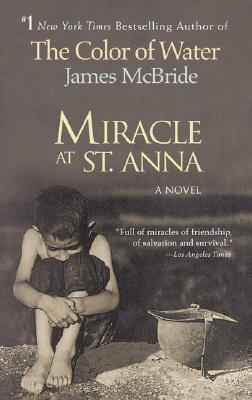Book Review: Miracle at St. Anna
by James McBride
List Price: $15.00Riverhead Books (Jan 07, 2003)
Fiction, Paperback, 336 pages
More Info ▶
Book Reviewed by Thumper
I wish all of my review assignments were like this one. It came upon me unexpectedly. I don’t need advance warnings when good things come my way, though. I had the privilege of reading James McBride’s fictional debut, the fabulous, wonderful (don’t have me get a thesaurus-I can go on and on) novel, Miracle at St. Anna. The novel can claim to be a marvelous miracle in it’s own right. I’m positive that literary critics and fans of McBride’s first book, The Color of Water, alike will be singing Miracle at St. Anna’s praises all year, for it deserves to have it’s praises sung. Based on a historical event, Miracle at St. Anna is easily one of the best books of the year!
I have a confession to make. I have to be the only person ON THE PLANET that has not read McBride’s first book, The Color of Water. It’s true. I’ve been intending to, but like that old saying goes, the road to Hell is paved with good intentions. I had no preconceived notion on McBride’s writing style or placed any expectation on Miracle at St. Anna. After reading Miracle at St. Anna, I can say that McBride is one hell of a novelist and Miracle at St. Anna is one phenomenal book!
I’m going to try to calm down and tell you the basic storyline of Miracle at St. Anna. The novel revolves around four soldiers (three African-Americans and one Puerto Rican) in the Army, fighting in 1944 war torn Italy. Sam Train, a somewhat slow-thinking giant of a man (6’6"), is told by Bishop; a charismatic, pessimistic former jackleg preacher, to save a little boy who’s hiding in a bush, in the middle of a hail of gunfire during a battle. Lieutenant Stamps and Hector Negron follows Bishop in an attempt to save Train, who had the young boy under his arm and had become scared, confused, and runs into enemy territory. This act leads the four servicemen and the small boy to a little village, St. Anna di Stazzema, the place of a recent massacre. The four servicemen entry into the village will change the lives of the men and the villagers while exploring history, race and humanity.
McBride made no bad moves throughout the novel. I had the sense that the research for the book was extensive. The historical facts were intricately, fluidly woven throughout the plot. There were times when the book read like a wholly interesting, captivating travelogue or geography schoolbook. I found myself fascinated by the historical footnotes. If authors of McBride talent wrote geography or history textbooks, young students would be less bored with the subjects. The narration was smooth and possessed an effortless flow moving from one setting, one time to another. McBride renderings of the different settings and time periods were meticulous without seeming tedious. There were times when I smelled the countryside, or the sweet burnt smell of flesh and wood.
McBride constructed three-dimensional characters that were multi-layered, wonderfully complex and constantly human. The characters brought their own individualities to the story. I can’t honestly say that one characters totally dominates my imagination over the others, but I have a special affection for Sam Train. Sam Train is a man whose innocence is touching and heart breaking. I would include Train with John Coffey from Stephen King’s The Green Mile, or Winston Groom’s Forrest Gump, and Lenny from Steinbeck’s Of Mice and Men as characters who represents the loss of innocence that we once had and secretly longs for. Train is unforgettable. I liked Bishop as well. McBride could have stayed with the stereotypical image of a jackleg preacher for Bishop, wisely he didn’t. Bishop not only brings an edge to Stamps, he evolves into a strong character whose veneer is just that, a cover, a protective shield guarding real pain and unanswered questions. McBride did a wonderful job with his supporting cast of characters, as well.
Let this serve as a warning to all of those who are diabetic and watching their sugar levels, or have bad teeth that are loaded with cavities, for this paragraph is loaded with accolades and praises for the novel. If your natural teeth are missing, the warning doesn’t apply to you, can’t hurt what ain’t there. Miracle at St. Anna is stupendous. It’s amazing, awe-inspiring, firmly rooted in facts and historical accounts, and narrated by the voice of a musician, a dreamer, a solid sho-nuff storyteller that one swears is a magician for he holds the ability to transport his listeners to another place and time complete with the senses of touch and smell. The novel is a stunning example of the best of humanity in a time of inhuman cruelty and depravity. Approaching the end of the book, McBride held my heart in his hands giving it little squeezes. The end of the book reduced me reduced to sobs. McBride struck that fine balance of incorporating hard facts with human emotions and the depth, consequences and motivation of those emotions composing an incredibly touching, heart-aching, soul lifting story. Miracle at St. Anna is an awesome book.

